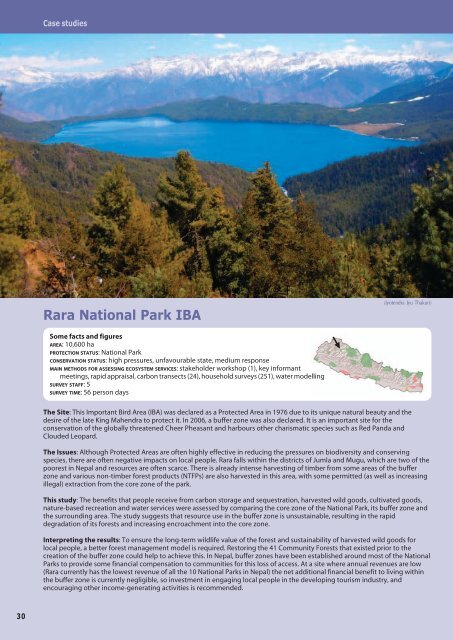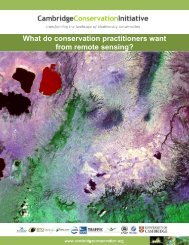CONSERVING BIODIVERSITY & DELIVERING ECOSYSTEM SERVICES
conserving biodiversity & delivering ecosystem services
conserving biodiversity & delivering ecosystem services
Create successful ePaper yourself
Turn your PDF publications into a flip-book with our unique Google optimized e-Paper software.
(Jyotendra Jyu Thakuri)<br />
Some facts and figures<br />
AREA: 10,600 ha<br />
PROTECTION STATUS: National Park<br />
CONSERVATION STATUS: high pressures, unfavourable state, medium response<br />
MAIN METHODS FOR ASSESSING <strong>ECOSYSTEM</strong> <strong>SERVICES</strong>: stakeholder workshop (1), key informant<br />
meetings, rapid appraisal, carbon transects (24), household surveys (251), water modelling<br />
SURVEY STAFF: 5<br />
SURVEY TIME: 56 person days<br />
The Site: This Important Bird Area (IBA) was declared as a Protected Area in 1976 due to its unique natural beauty and the<br />
desire of the late King Mahendra to protect it. In 2006, a buffer zone was also declared. It is an important site for the<br />
conservation of the globally threatened Cheer Pheasant and harbours other charismatic species such as Red Panda and<br />
Clouded Leopard.<br />
The Issues: Although Protected Areas are often highly effective in reducing the pressures on biodiversity and conserving<br />
species, there are often negative impacts on local people. Rara falls within the districts of Jumla and Mugu, which are two of the<br />
poorest in Nepal and resources are often scarce. There is already intense harvesting of timber from some areas of the buffer<br />
zone and various non-timber forest products (NTFPs) are also harvested in this area, with some permitted (as well as increasing<br />
illegal) extraction from the core zone of the park.<br />
This study: The benefits that people receive from carbon storage and sequestration, harvested wild goods, cultivated goods,<br />
nature-based recreation and water services were assessed by comparing the core zone of the National Park, its buffer zone and<br />
the surrounding area. The study suggests that resource use in the buffer zone is unsustainable, resulting in the rapid<br />
degradation of its forests and increasing encroachment into the core zone.<br />
Interpreting the results: To ensure the long-term wildlife value of the forest and sustainability of harvested wild goods for<br />
local people, a better forest management model is required. Restoring the 41 Community Forests that existed prior to the<br />
creation of the buffer zone could help to achieve this. In Nepal, buffer zones have been established around most of the National<br />
Parks to provide some financial compensation to communities for this loss of access. At a site where annual revenues are low<br />
(Rara currently has the lowest revenue of all the 10 National Parks in Nepal) the net additional financial benefit to living within<br />
the buffer zone is currently negligible, so investment in engaging local people in the developing tourism industry, and<br />
encouraging other income-generating activities is recommended.




